Abstract
There is currently an effort to scale up sol–gel nanomaterials without compromising quality, and microwave heating can pave the way for this due to its heating efficiency, resulting in a fast and homogeneous process. In this work, the sol–gel synthesis of transition metal aerogels, specifically iron-based aerogels, is studied using a microwave-assisted sol–gel methodology in an open-system multimode device as a potential route to scale-up production. Different approaches were tested to evaluate the best way to increase yield per batch, with different vessel shapes and volumes. It is shown that the shape and size of the vessel can be determinant in the interaction with microwaves and, thus, in the heating process, influencing the sol–gel reactions and the characteristics and homogeneity of the obtained nanomaterials. It has been found that a wide vessel is preferable to a tall and narrow one since the heating process is more homogeneous in the former and the sol–gel and cross-linking reactions take place earlier, which improves the mechanical properties of the final nanomaterial. For mass production of nanomaterials, the interaction of the reagents with the microwave field must be considered, and this depends not only on their nature but also on their volume, shape, and arrangement inside the cavity.
1. Introduction
Sol–gel synthesis offers several advantages, including precise control over each chemical stage—from the formation of the initial sol to particle crosslinking, gelation, and the development of a final 3D nanostructure [1,2]. By adjusting the initial operational conditions, the final material properties can be finely tuned. This flexibility is particularly valuable for synthetic material applications, enabling tailored performance, improved functionality, and the ability to address specific challenges [2,3,4]. However, the crosslinking step can be time- and energy-intensive, often requiring hours or even days and typically relying on conventional heating methods (i.e., convection and conduction heat transfer) [5]. These thermal limitations can result in heterogeneous heating, inefficient reaction kinetics, and limited scalability, which is particularly problematic for designing sol–gel materials with controlled nanostructures [6]. A promising alternative is microwave heating, a relevant approach for optimizing sol–gel synthesis [7,8,9], that reduces energy consumption and shortens synthesis times [10,11]. Microwave-assisted sol–gel synthesis has been successfully employed to produce various metal oxide nanoparticles, including titanium dioxide (TiO2) [12,13,14], zirconia (ZrO2) [15,16], and silica (SiO2) [17,18] or even silica gels [19]. This technique offers several benefits, such as high crystallinity, uniform particle size, precise phase composition control, high purity, and increased specific surface area—all achieved in significantly short times [13,15,18]. These oxides are widely used in applications such as photocatalysis, biomedicine, and corrosion protection, in which material performance depends heavily on structural precision.
In the field of energy applications, other metals—especially noble metals like iridium and platinum—have also been utilized. Gels composed of these metals have been synthesized using microwave-assisted methods, benefiting from the efficiency and advantages of this technique [20,21]. Nonetheless, two key challenges remain in the development of metallic materials for energy applications. First, the high cost and limited availability of noble metals require the search for alternatives that offer comparable electrochemical performance while enabling broader technological adoption. A promising approach involves the development of transition metal-based electrocatalysts, which are more abundant and cost-effective [22,23]. The second challenge is scaling up sol–gel synthesis without compromising material quality. This is essential for industrial deployment of energy devices, which require large-scale production of electrocatalysts while maintaining their desired properties [24]. However, scaling up microwave-assisted synthesis involves great complexity, particularly for sol–gel methodologies, such as ensuring homogeneous heating in large volumes, managing electromagnetic field distribution, and maintaining consistent product quality across batches [25]. The general benefits of microwave-assisted techniques are well known, particularly in some industrial applications, such as microwave drying processes [26], but it remains unclear how these advantages specifically manifest in the synthesis of transition metal-based aerogels (TMA) or how they can be leveraged to overcome key barriers in practical applications. Among the different TMAs, iron aerogels attract much attention due to their higher specific surface area, modulated magnetic properties, and combination of electrical conductivity and structural stability [27,28,29]. Nonetheless, their synthesis process involves unique challenges, including difficulties in achieving uniform gelation and the need for strict control of redox and pH conditions during synthesis [27,28], particularly in the microwave-assisted synthesis in which the reaction rates are much faster.
The use of microwave heating offers a more efficient form of heating, with a direct action on the precursor mixture and not on the surrounding air, minimizing the occurrence of gradients and, therefore, heterogeneities since it is a bulk heating option. The most effective and versatile method is the multi-mode since the microwaves generated are used to the maximum inside the cavity, and it is not necessary to adapt the generated wave to the specific material to be heated. It must be considered that in sol–gel synthesis, the reactions that take place cause constant changes in the material, and these changes will also influence their interaction with the microwaves. However, many other factors may also modify the effective interaction of the microwaves with the precursor solution, such as the position of the sample to be heated inside the cavity, the volume and shape of the container or even the presence of other objects that may alter the field (i.e., thermocouple that may act as antenna). In this work, different approaches for scaling-up iron aerogels are tested and discussed with the aim to explore how microwave operational parameters affect the structural characteristics and performance of iron aerogels (FeA), specifically through the evaluation of the influence of reactor design parameters—such as vessel shape and power-to-volume ratio, rarely optimized or even reported—on the structural and physicochemical properties of the resulting aerogels to demonstrate the feasibility of scaling up the synthesis process without compromising material performance. To this end, iron aerogels were synthesized with a well-defined morphology, a narrow nodular size distribution, and a relatively high surface area for metallic materials. These characteristics make them highly promising candidates for electrochemical applications, demonstrating good stability during reactions [29]. In this work, the feasibility of different scaling methods was assessed through experimental observations using a thermal camera and theoretical simulations of the microwave cavity’s internal field. The analysis revealed that certain shapes and volumes employed for the upscaled synthesis of FeA are not feasible, while others successfully preserve the aerogels’ properties.
2. Materials and Methods
Iron-based aerogels (FeA) were synthesized by a microwave-assisted sol–gel methodology. A detailed description of the procedure can be found elsewhere [28]. Briefly, aqueous solutions of FeCl2 as the metallic precursor (M) and a reducing mixture (R) of sodium carbonate and glyoxylic acid were prepared. Specifically, FeCl2 (2 mg·mL−1, Sigma-Aldrich, St. Louis, MO, USA, 98%) was dissolved in distilled water to form solution M, while solution R was prepared by dissolving 1.5 g of Na2CO3 (Indspec, Pittsburgh, PA, USA, 99%) and 250 mg of glyoxylic acid (Sigma-Aldrich, St. Louis, MO, USA, 98%) in 250 mL of deionized water. M and R were then combined in a volumetric ratio of 1:4, with a total volume of 80 mL. The resulting mixture was placed in microwave-transparent glass vessels of different geometries (shown in Figure 1) and subjected to microwave heating at a temperature of 68 °C for 1 h. The microwave device was a modified multimode microwave oven in-lab, designed and constructed, equipped with a thermocouple and PID controller for accurate temperature monitoring and control. A photograph of this device is provided in Figure S1. The thermocouple is inserted into the solution through a narrow hole in the container lid or in the temperature-resistant DuraSeal™ (Diversified Biotech, Dedham, MA, USA) employed to seal the small vessels, thereby preventing evaporation issues and maintaining an unaltered reaction atmosphere. This setup enabled a systematic investigation of the effects of container geometry and power-to-volume ratio on the structural and physicochemical properties of the resulting aerogels, providing insights into the synthesis process and ensuring reproducibility across different vessel configurations and batches. Each aerogel synthesis was repeated a minimum of three times, and in all cases, the resulting morphologies were systematically consistent.
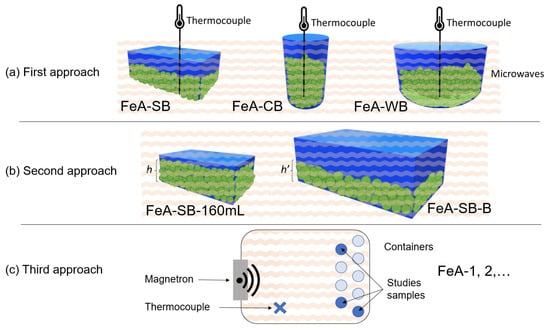
Figure 1.
Scheme of the three strategies studied for microwave-assisted sol–gel synthesis: (a) evaluation of the influence of the shape of the vessel, (b) evaluation of the influence of the volume of the vessel, and (c) evaluation of replicating vessels on the microwave cavity.
In the first approach studied, the precursor solution was poured into containers with different shapes. This is a key aspect due to their different interactions with microwaves and, therefore, key to reach the synthesis temperature homogeneously. Three different vessels were employed for the synthesis of FeA: (i) a squared base vessel of 270 mL (sample FeA-SB), (ii) a circular base vessel of 100 mL (sample FeA-CB), and (iii) a wide cylindrical beaker of 500 mL (sample FeA-WB) with a base greater than in the previous sample. A schematic description of each vessel is provided in Figure 1a. The same composition and volume of precursor solution (i.e., 80 mL) detailed above were used in all three cases.
In the second approach, the same shape of the vessel was used (i.e., squared base vessel) but changed to a larger volume (container of 500 mL) that allowed double the volume of the precursor mixture (160 mL of precursor solution) but with a similar ratio of volume/size. These samples obtained were labeled FeA-SB-B. Another option for increasing the volume of the precursor mixture in the same container as the first approach was also evaluated (160 mL of precursor solution in a container of 270 mL), and the samples obtained were denoted as FeA-SB-160 mL. The composition of the precursor mixture was maintained in comparison with the previous strategy and was equal in both containers.
Finally, the last approach evaluated involved placing 10 cylindrical containers of the same volume (100 mL) at different points of the microwave cavity (as shown in Figure 1c), controlling the temperature in only one of them with a thermocouple. The same composition and volume of precursor solution (i.e., 80 mL) detailed above were used in all 10 cases. The samples obtained were labeled FeA-X, where X denotes the position inside the cavity.
FeA was physicochemically characterized by Scanning Electron Microscopy (SEM) in order to evaluate the morphology of the aerogel obtained in each approach. The SEM used was a Quanta FEG 650 microscope (from FEI, Hillsboro, OR, USA) with an Everhart-Thornley Detector (ETD). An accelerating voltage of 20 kV and a spot size of 3 nm were used in all the analyses. Powder X-ray diffraction (D8 ADVANCE diffractometer, Bruker, Billerica, MA, USA) was employed for the identification of crystalline and chemical features in the different FeA. The data was collected over a 2θ range from 30° to 60° with a step size of 0.02°. The identification of the crystalline phases was carried out using the Diffrac EVA software v7. The porosity characterization, a crucial aspect for sol–gel materials, was performed by N2 adsorption–desorption isotherms measured at −196 °C in a Tristar 3020 (Micromeritics Instrument Corp., Norcross, GA, USA). The samples were outgassed before the analysis at 60 °C and 0.1 mbar overnight in a Micromeritics VacPrepTM 061 station (Micromeritics Instrument Corp., Norcross, GA, USA). The specific surface area (SBET), the external surface area (Sext), and the volume of micropores were calculated by the BET equation [30], the t-plot method [31], and the Dubinin–Radushkevich method [32,33], respectively. Pore size distribution was also calculated by means of the 2D-NLDFT model from the N2 adsorption–desorption isotherms.
The influence of microwave heating on the sol–gel process at a fundamental level can be explored by examining how electromagnetic fields behave within the microwave cavity. Understanding this interaction is essential for optimizing the uniformity and efficiency of the heating process, especially when dealing with heterogeneous systems like those observed experimentally. Theoretical modeling provides a means to simulate and predict how microwaves interact with materials inside the cavity, which can help explain the spatial temperature variations and their consequences on material formation.
In this work, a multimode microwave device was used to generate microwaves that bounce in all directions inside the cavity. During the process, the electric and magnetic fields couple with the temperature field in a non-linear manner and with infinite dimensionality [34]. This behavior can be described by Maxwell equations and boundary conditions that depend on the type and the geometry of the applicator [35]. Cavities generally exhibit a large number of resonant modes, and the frequencies extend up to the cutoff frequency for both Transverse Electric (TE) and Transverse Magnetic (TM) modes, which is the lowest frequency at which a wave can propagate efficiently within that waveguide. Above or below the cut-off frequency, the wave can be propagated or attenuated, respectively. The specific cut-off frequency depends on the waveguide’s geometry and the specific mode [36]. A resonant cavity model can be used to understand the behavior of the electromagnetic waves in the microwave cage [37]. The simplified model requires the Helmholtz equation with perfect conducting walls as boundary conditions.
where is the electric field and , being the wave number.
For a rectangular cavity of dimensions ··, the solution is found using sinusoidal modes:
The resonant frequencies can be calculated as
where is the wave velocity, and , , and are the mode indices.
The cavity dimensions and operating conditions of the microwave device used in this work are summarized in Table 1. The resonant modes obtained in the experimental approaches can be calculated by Equation (3), using the cut-off frequency TE. For 3, there are more than 30 modes, as presented in Table 2.

Table 1.
Parameters regarding the microwave oven employed in this work.

Table 2.
Calculated resonant modes for 3 with a frequency lower than 2.45 GHz.
In order to have a uniform field inside the cavity, the microwave device used in this work has wave diffusers trying to homogenize the energy inside the cavity. Moreover, since the microwave is designed as a waveguide rather than a fully enclosed cavity, the fundamental dimensions for field propagation are transversal to the propagation axis. This implies that not all modes are capable of carrying energy. Therefore, although the TE001 mode exhibits the lowest cutoff frequency, it has a longitudinal component ( = 1) that prevents efficient energy transmission through the waveguide. Consequently, the mode TE010 carries the maximum power efficiently and features a symmetric field pattern as shown in Figure 2a.
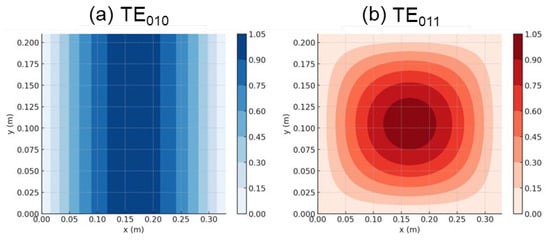
Figure 2.
(a) TE010 fundamental mode in microwave cavities, exhibiting a single field variation in one transverse direction. (b) TE011 higher-order mode with field variation along the axial direction of the cavity.
Figure 2 offers a representation of Transverse Electric (TE) modes characterized by an electric field with no component in the direction of propagation. TE010 produces a relatively uniform field distribution, whilst TE011 leads to a more complex interference pattern.
The electromagnetic resonance modes within a microwave cavity determine the spatial distribution of the electromagnetic field, directly influencing the heating behavior. While less commonly observed, modes like TE011—along with other higher-cutoff-frequency modes—highlight the importance of mode selection in electromagnetic simulations. In this study, the TE010 mode is selected for cavity modeling, as it is the dominant and most representative mode in standard microwave operation.
Considering the TE010 mode, the electric field varies sinusoidally along the x-axis and remains uniform along the y-axis. The resulting temperature field is proportional to the electric field. The attenuation due to absorption by the material in TE and TM modes is different. But with the approximation that water is the major component in the precursor solution, and that the reaction time is 1 h, the attenuation considered for a Δx, Δy is practically negligible. Additionally, it must be taken into account that an attenuation gradient exists as the distance from the origin of the wave increases. For the modeling, a non-linear attenuation of the following type has been considered:
where is the Euclidean distance to the magnetron.
3. Results and Discussion
The sol–gel methodology allows for tailoring the properties of a material by modifying the synthesis conditions. Usually, operational variables such as the temperature of the reaction or residence time, as well as chemical variables such as the ratios of the different precursors in the initial solution or even the amount of solvent (i.e., dilution) are modified to control the sol–gel reaction, and hence, the final properties. However, in the synthesis procedure with conventional heating, the occurrence of temperature gradients can also influence the reactions taking place, producing heterogeneous materials, making it very difficult to control the final properties and to scale the process. While microwave heating is not only an efficient way of heating but also highly homogeneous, offering numerous advantages for materials synthesis, there are several aspects that must be taken into account, especially considering production scale-up. Some of these aspects are discussed in the following sections.
3.1. Scaling-Up Iron Aerogels by Multimode Microwave Heating
3.1.1. First Aspect to Consider: Shape of the Vessel
Three vessel shapes with the same volume (80 mL) and composition of precursor solution were tested for the production of FeA by microwave heating, as shown in Figure 1. The masses of each aerogel obtained by this method were 34, 37, and 29 mg for samples FeA-SB, FeA-CB, and FeA-WB, respectively. These differences are within the experimental error attributed to material loss during the aerogel washing process. The shape of the container defines the shape of the volume of the solution interacting with the microwave field, and this can be relevant for the heating process and, therefore, for the quality of the final nanomaterial obtained. It is worth remarking here that the ratio volume/power was the same in all three cases. However, as can be seen in Figure 3, some differences in the morphology of the final aerogels were detected. The SEM images reveal changes in the size of the typical nodules that formed the aerogels, increasing the size in the following order: FeA-WB < FeA-CB < FeA-SB (i.e., 32, 49, and 74 nm, respectively). This means that the heating process of each precursor solution varied in each case due to the different interactions of the vessel shape with the microwave field. This influence is particularly noticeable in the first step of the sol–gel reaction, in which the initiation or nucleation points are created, as it is corroborated by the infrared camera in Figure S2. There, it can be seen that sample FeA-WB reached the operating temperature in less time than the other two samples, favoring the formation of a great number of initiation points with small sizes. On the other hand, the FeA-SB sample exhibited a narrower temperature distribution during the heating process, resulting in more stable and controlled heating. This means that the heating process is retarded, so fewer initiation points are created and the precursors tend to react to grow up those. Therefore, it can be inferred that the square-based vessel is heated more gradually than the wide beaker, and thus, the size of the nodules in the former is nearly double the size of the latter.
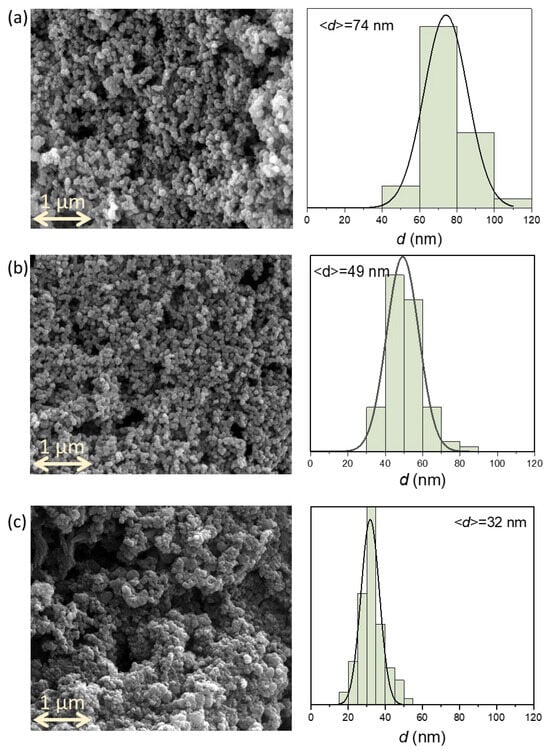
Figure 3.
SEM images and cluster size distributions of FeA synthesized in containers with the same volume but different shapes: (a) square base (FeA-SB), (b) cylindrical base (FeA-CB), and (c) wide cylindrical beaker (FeA-WB).
For aerogels, the porosity is primarily due to the formation of interstitial voids between the nodules formed. The volume of these voids or pores depends on the size of the nodules and their crosslinking degree. This structural characteristic is particularly advantageous in electrocatalytic processes, as it promotes the diffusion of reactants and products of the chemical reactions, besides determining the active surface area for the electrocatalyst. In light of this, the porous properties of the aerogels obtained from the different vessels have been characterized.
N2 adsorption–desorption isotherms have been performed to evaluate textural properties (Figure 4a). All samples show Type II- isotherms according to IUPAC classification [31], indicating that the aerogels are mainly macroporous with a low presence of meso- and microporosity. However, some differences can be observed within the micro-mesoporous range. Although all samples appear to exhibit quite similar volumes of micropores (i.e., 0.03–0.04 cm3 g−1), the volume adsorbed at low relative pressures increases in the following order: FeA-SB > FeA-CB > FeA-WB. This results in a slightly higher BET surface area (82, 84, and 86 m2 g−1 for samples FeA-SB, FeA-CB, and FeA-WB, respectively). This trend is in agreement with the nodule sizes determined by the SEM images, as a larger number of small nodules gives rise to higher surface areas. On the other hand, the same trend is observed in the external surface area (Sext = 81, 82, and 82 m2 g−1 for samples FeA-SB, FeA-CB, and FeA-WB, respectively).
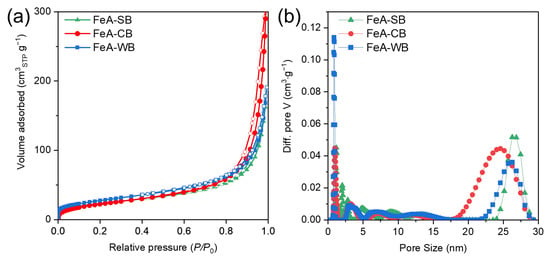
Figure 4.
N2 adsorption–desorption isotherms (a) and pore size distribution (b) for the iron aerogels obtained employing vessels of different shapes.
Regarding the shape of the isotherm at high relative pressures, FeA-WB and FeA-SB display identical volume adsorbed, indicating similar total volume of pores (0.29 cm3 g−1), while FeA-CB exhibits greater adsorbed volumes at high relative pressures (0.48 cm3 g−1), indicating a larger volume of mesopores. In addition, the range of pressures at which the hysteresis loop appears indicates that this last sample developed wide pores (i.e., wide mesoporosity). In general, larger nodule sizes lead to larger pore sizes and vice versa, which is in agreement with the results of sample FeA-SB. However, sample FeA-WB has the smallest nodule size, but the nodules are aggregated, leaving larger voids (i.e., mesoporosity of larger size and macropores) between them, as shown in Figure 4b. Sample FeA-CB, on the other hand, presents intermediate nodule sizes with no aggregations and, therefore, a more abundant presence of large mesoporosity of small size, leading to larger N2 adsorption volumes at the saturation point. These discrepancies in samples FeA-WB and FeA-CB are probably due to the shape of the vessel. Taking into consideration the ratio between the height of the precursor solution and the base of the vessel employed (0.25, 1.1, and 0.48 for samples FeA-SB, FeA-CB, and FeA-WB, respectively), it can be inferred that the highest ratio results in the highest volume of mesopores with smaller sizes. The nodules have less space to distribute along the base, leaving smaller voids between them, hence resulting in pores of small size (FeA-CB presents a wider distribution of mesopores centered at 25 nm). Contrarily, with a lower height/base ratio, the nodules are more separated and, therefore, give rise to mesopores of larger size and higher microporosity (FeA-WB has an intermediate mesopore distribution between the three samples, with an average size of 26 nm, and FeA-SB has the narrowest mesopore distribution, in accordance with the lowest height-to-base ratio, with mesopores centered at 27 nm).
Therefore, the shape of the container has influenced the final properties of the aerogels, affecting cluster size and, therefore, porosity of the nanomaterials obtained. The different reactions occurring may also influence the chemical composition of the final iron aerogel. In order to check this point, samples were also analyzed by PXRD to detect possible changes in crystallinity and chemical composition (Figure 5).
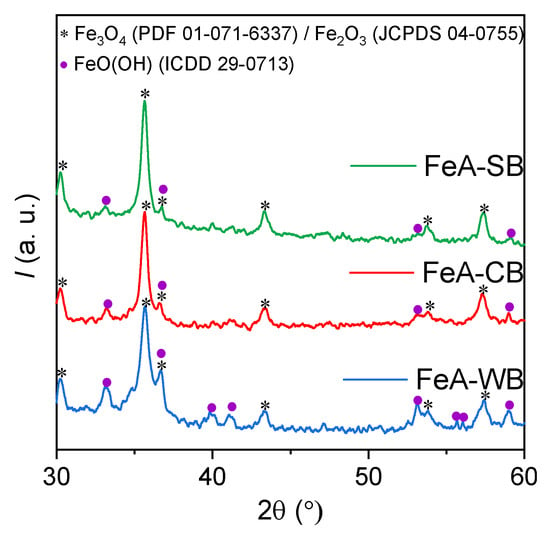
Figure 5.
X-ray diffractograms for the iron aerogels obtained employing vessels of different shapes.
The diffractograms show minor changes in crystallinity, related to the morphology developed in the samples studied; consequently, the chemical composition remains unchanged. The three samples present a mixture of iron oxide phases. However, the intensity of these phases seems to change, the non-magnetic phase FeO(OH) being more intense for FeA-WB than for FeA-SB and FeA-CB. Crystalline sizes were calculated using the Scherrer equation. The first three most intense peaks were selected to avoid the splitting of the Kα1 and Kα2 lines and to minimize instrumental error. FeA-SB exhibits nanocrystals with an average size of 30.8 nm, while FeA-CB and FeA-WB contain nanocrystals of 29.7 nm and 29.5 nm, respectively. These values corroborate the wider sizes detected for FeA-SB in SEM images.
3.1.2. Second Approach: Volume of the Vessel
An additional aspect to consider, beyond the geometry of the container, is the volume of precursor solution concerning the power of the microwaves used. This ratio will directly influence the heating process and therefore the promotion of the reactions occurring. Therefore, in this second approach, the volume of the precursor solution was changed, whilst the rest of the operating variables were maintained (i.e., set-point temperature, time of reaction, composition of the precursor solution).
The previously described aerogel FeA-SB, obtained from 80 mL of precursor solution in a 270 mL square-based container, was used as a reference. This sample was formed by nodules with an average diameter of 74 nm (see Figure 3a). With the aim to increase the yield per batch, the precursor solution volume was doubled to 160 mL in a container almost two times bigger (500 mL), leading to a total mass of 70 mg, double that obtained from 80 mL. This iron aerogel (FeA-SB-B) was successfully produced, as can be observed in Figure 6a. Typical nodular morphology was obtained with double yield in the same batch production.
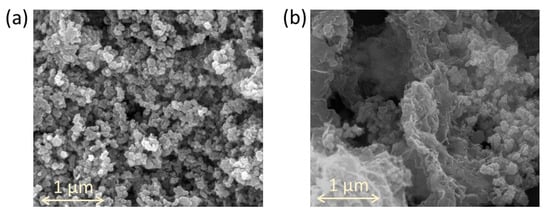
Figure 6.
SEM images of the iron aerogels obtained from a 160 mL precursor mixture in a square-based container of (a) 500 mL, FeA-SB-B, and (b) 250 mL, FeA-SB-160 mL.
Regarding the porosity developed by these samples, if the N2 adsorption–desorption isotherms are compared (Figure 7), it can be seen that there are only some slight differences between both samples. The sample FeA-SB-B presents slightly higher adsorbed volume at low and intermediate relative pressures, indicating a higher volume of micro- (0.033 cm3 g−1 vs. 0.029 cm3 g−1) and narrow mesopores, respectively, than FeA-SB. However, the total volume adsorbed at the saturation point is quite similar (ca. 0.29 cm3 g−1), indicating a similar total porosity due to similar mean nodule size in both cases (ca. 70 nm).
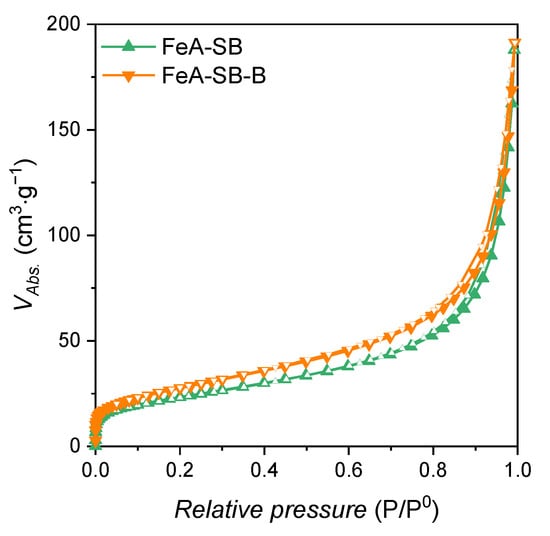
Figure 7.
N2 adsorption–desorption isotherms of FeA-SB-B (obtained from 160 mL of precursor solution in a 500 mL vessel) in comparison with FeA-SB (obtained in 80 mL of precursor solution in a 270 mL vessel).
The alternative to use a bigger volume (160 mL) of precursor solution in the same container as the FeA-SB sample (i.e., 270 mL) was also evaluated. In this case, the aerogel obtained was denoted as FeA-SB-160 mL, and the height of the initial hydrogel formed in the precursor solution was obviously higher.
The packing pressure of this interconnected 3D structure formed in the first stages of reaction may affect the morphology of the final aerogel, changing it to a mixture of nodules and some flake-like nanostructures (Figure 6b). In addition to pressure, another cause of these heterogeneities compared to the morphology observed in the FeA-SB and FeA-SB-B samples is that increasing the height of the precursor solution column leads to less uniform heating. The reason for this is that the electromagnetic field is more homogeneous in the XY plane, which means that choosing a geometry with a larger base and a shorter column height positively influences the scalability potential of the samples (see Figure S3). As a consequence, the option to increase the volume in the same container with the same operating parameters has to be discharged, as the control of the nanostructured material is lost. Other operational adjustments, such as the power-to-volume ratio or reaction time, can be considered to enhance certain reactions and thus reinforce the mechanical properties of the initially formed aerogel and maintain the nodular morphology. However, this is beyond the scope of this work.
Therefore, it can be concluded that in addition to the shape, the volume of the vessel is also a key factor to bear in mind for scaling-up microwave-assisted sol–gel production of nanomaterials.
3.1.3. Third Approach: Replicating Small Volumes
Another possible approach to increasing the mass yield of the aerogels in a single batch, at least at laboratory scale, is to replicate the vessels within the microwave cavity. This option could be interesting to obtain several aliquots of analogous nanomaterials for basic science testing. Obviously, it is not an efficient option to scale up production for commercial use, as the cost of the larger number of vessels, especially the time spent to prepare and collect the samples, is higher than using a single and big container. In this approach, nine circular-based containers were distributed inside the microwave’s cavity with the same volume of the precursor solution (80 mL). A tenth container was also placed with the thermocouple in order to control the temperature (i.e., marked with X in Figure 8a). It is assumed that the use of a multi-mode microwave equipped with a wave diffuser would ensure that all the containers would interact with the microwaves in the same way and, therefore, the heating would be analogous in all of them. The aerogels obtained at three random positions (see Figure 8a) were characterized and denoted as FeA-1, FeA-2, and FeA-3. Taking the lower left corner of the microwave depicted in Figure 8a as the origin of coordinates, the magnetron would be represented at position (0, 16.5 cm), the thermocouple with one of the vessels at position (11.5 cm, 10.0 cm), and the vessels giving rise to the aerogels FeA-1, FeA-2, and FeA-3 would be at positions (21.5 cm, 26.5 cm), (21.5 cm, 6.7 cm), and (28.2 cm, 3.4 cm), respectively. The positions are given at the point at which the vessels are centered; all vessels have a diameter of 3.5 cm.
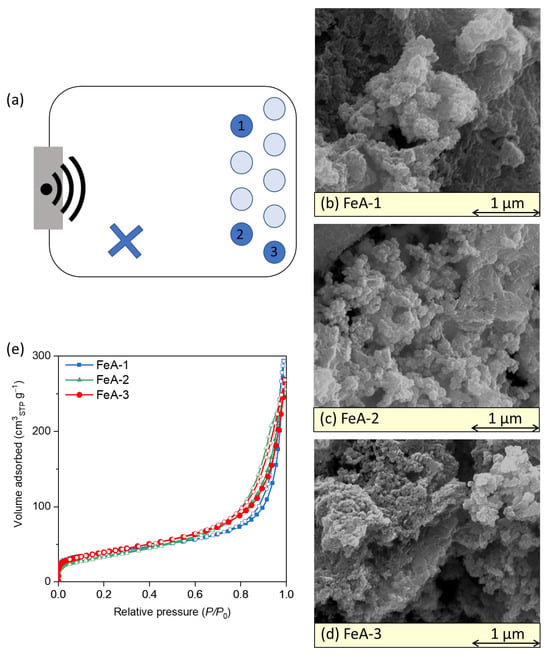
Figure 8.
Microwave cavity scheme with the position of the 9 cylindrical containers, the container with the thermocouple (marked with X), and the magnetron (a). SEM images (b–d) and N2 adsorption–desorption isotherms (e) of the nanomaterials obtained at positions 1–3.
Samples FeA-1, FeA-2, and FeA-3 exhibit a nodular structure with no significant differences between them (Figure 8b–d). However, these nodules seem to be fussed in comparison to the aerogels obtained from Section 3.1.1 and Section 3.1.2 discussed above. This could be due to the different heating processes undergone. In fact, these FeA-1, -2, and -3 nanomaterials were not heated adequately because they are not centered in the microwave cavity. Therefore, the nodules are not sufficiently cured, and in these cases, the final aerogel structure may collapse during drying. This change in morphology obviously has an effect on the textural properties of the nanomaterials obtained, as shown in Figure 8e.
The N2 adsorption–desorption isotherms reveal that the porosity of the sample FeA-2 differs slightly from that of FeA-1, although their positions in the microwave cavity are symmetrical. Samples FeA-2 and FeA-3 present analogous N2 adsorption isotherms, indicating analogous porous development. However, FeA-1 exhibits lower adsorption at intermediate relative pressures and slightly higher adsorbed volume at the saturation point than the other two samples (ca. 0.45 vs. 0.41 cm3 g−1), indicating a lower volume of narrow mesopores and the presence of wider pores. These characteristics may indicate that the area of position 1 in the cavity is not heated in the same way as positions 2 and 3, and the reasons could be several: an uneven distribution of the field, interference due to the different containers, or even an antenna effect by the thermocouple. On the other hand, an average mass of 36 mg was obtained from each vessel, representing the most productive strategy in terms of mass yield. This approach could be further optimized, if necessary, by appropriately adjusting the reaction time and set-point temperature to ensure complete curing of the aerogel and preserve the integrity of the nodular structure during the drying process.
To gain a deeper understanding of the morphological differences observed and the role of microwave heating in the sol–gel process, it is crucial to examine the theoretical principles governing the interaction between electromagnetic fields and the reaction medium. The behavior of the vessels within the microwave cavity can be simulated based on theoretical calculations of the electromagnetic field distribution during the sol–gel reaction. By integrating this theoretical framework with the experimental findings discussed above, the simulation offers valuable insights into the heating dynamics and their influence on the final properties of the resulting materials.
This third approach can be modeled, according to the equations mentioned in Section 2 and incorporating 10 cylindrical vessels (3.5 cm diameter). However, for simplification, it is assumed that vessels produce a minimal field distortion. The field was normalized to have 68 °C at the position of the thermocouple, which also assumes that it does not produce any distortion or antenna effect in the cage.
As can be seen in Figure 9, the temperature distribution may not be uniform throughout the cavity, so the position of the small vessels will be very relevant to the reactions occurring, which could complicate scaling up with this approach. The model used is very simplistic, and interactions with the containers and compounds in the precursor solutions also interfere and have not been considered here. Furthermore, the thermocouple can act as an antenna for the microwaves, which could concentrate the field and, therefore, the heating process in that area. This latter effect could explain the differences in heating of the FeA-1 and FeA-2 samples, despite their symmetrical positions within the cavity and apparently being at the same temperature according to the simulation shown in Figure 9. The thermocouple would favor heating positions 2 and 3 over position 1 in the experimental procedure.
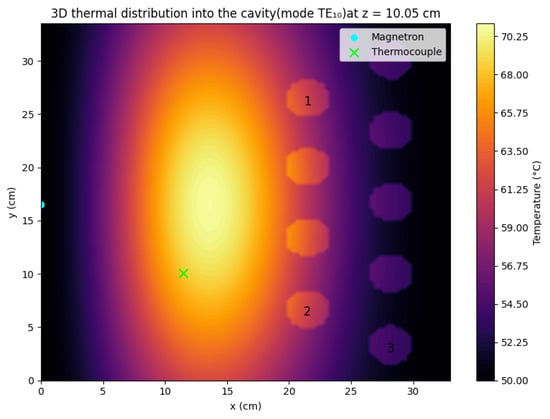
Figure 9.
Temperature mapping inside the microwave cavity considering the TE10 mode. Magnetron, thermocouple, and vessels are also represented.
Nevertheless, with these simple calculations, it can be deduced that the best strategy to increase nanomaterial production would probably be to use a single large container, located in the center of the cavity.
4. Conclusions
This work addresses the first steps for scaling up iron aerogels, a nanomaterial of great interest for use as an electrocatalyst in clean energy generation, using microwave-heating technology. It has been shown that the interaction of the microwave field with the precursor solution and, therefore, the heating generated depends on the shape of the container, being more homogeneous and rapid if the ratio between the height and the base of the vessel employed is low. Therefore, based on the tests performed, it is preferable to increase the size of the container in line with the volume of the precursor solution rather than simply the volume of the precursor solution in the same container. Replicating multiple containers within the microwave cavity is the least advisable option to avoid heating heterogeneities. According to the theoretical distribution of the TE010 mode of the electromagnetic field, the most stable heating would occur at the center of the cavity, particularly along the Y-axis of the plane. Therefore, considering this and the experimental infrared camera results, the most optimal configuration for scaling up would involve placing a low and wide vessel at the center of the cavity and aligned with the Y-axis.
Supplementary Materials
The following supporting information can be downloaded at: https://www.mdpi.com/article/10.3390/microwave1020006/s1, Figure S1: microwave employed in this work; Figure S2: Infrared camera images and temperature profiles of FeA-SB, FeA-CB, and FeA-WB; Figure S3: Infrared camera images and temperature distribution of FeA-WB, and FeA-SB-B.
Author Contributions
Conceptualization, A.A.; software, J.G.-L.; formal analysis, J.G.-L.; data curation, J.G.-L. and A.A.; writing—original draft preparation, J.G.-L.; writing—review and editing, N.R.-R. and A.A.; supervision, A.A.; project administration, N.R.-R.; funding acquisition, N.R.-R. All authors have read and agreed to the published version of the manuscript.
Funding
This research was funded by MCIN/AEI/10.13039/501100011033/FEDER-UE through PID2022-139493OA-100 project. NRR thanks the RyC2021-031456-I and CNS2023-144627 grants funded by MCIN/AEI/10.13039/501100011033 and European Union NexGenerationEU/PRTR. JGL is grateful to the Principado de Asturias for her PhD grant from the Severo Ochoa Program.
Institutional Review Board Statement
Not applicable.
Informed Consent Statement
Not applicable.
Data Availability Statement
Data is contained within the article or Supplementary Materials. The original contributions presented in this study are included in the article. Further inquiries can be directed to the corresponding authors.
Conflicts of Interest
The authors declare no conflicts of interest.
Abbreviation
The following abbreviations were used throughout the manuscript:
| TMA | Transition metal aerogel |
| FeA | Iron aerogel |
| FeA-SB | Iron aerogel synthesized in a square-based vessel of 250 mL with 80 mL of precursor solution |
| FeA-CB | Iron aerogel synthetized in a circular-based vessel |
| FeA-WB | Iron aerogel synthetized in a wide circular-based vessel |
| FeA-SB-160mL | Iron aerogel synthetized in a square-based vessel of 250 mL with 160 mL of precursor solution |
| FeA-SB-B | Iron aerogel synthetized in a square-based vessel of 500 mL with 160 mL of precursor solution |
| FeA-1 FeA-2 FeA-3 | Iron aerogels synthetized in circular vessels of 100 mL with 80 mL of precursor solution situated at different positions inside the microwave cavity |
| TE | Transverse Electric mode |
| TM | Transverse Magnetic mode |
References
- González-Lavín, J.; Martínez Lázaro, A.; Rodríguez-Barajas, M.; Ledesma, J.; Arriaga, L.; Arenillas, A.; Rey-Raap, N. Metallic Aerogels for Their Use in Sustainable Energy Generation. In Electrochemical Methods for the Synthesis and Analysis of Advanced Functional Layers and Coatings; Kozhukharov, S.V., Ed.; Cambridge Scholars Publishing: Newcastle upon Tyne, UK, 2024; pp. 1–42. ISBN 9781036410964. [Google Scholar]
- Levy, D.; Zayat, M. The Sol-Gel Handbook; Wiley-VCH Verlag GmbH & Co.: Weinheim, Germany, 2015; pp. 1–1508. [Google Scholar] [CrossRef]
- Bokov, D.; Turki Jalil, A.; Chupradit, S.; Suksatan, W.; Javed Ansari, M.; Shewael, I.H.; Valiev, G.H.; Kianfar, E. Nanomaterial by Sol-Gel Method: Synthesis and Application. Adv. Mater. Sci. Eng. 2021, 5102014. [Google Scholar] [CrossRef]
- Esposito, S. Sol-Gel Synthesis Strategies for Tailored Catalytic Materials; Bhatia, S., Diebold, A., Hu, J., Krishnan, K., Narducci, D., Ray, S.S., Wilde, G., Eds.; Springer Briefs in Materials; Springer International Publishing: Turin, Italy, 2023; ISBN 978-3-031-20722-8. [Google Scholar]
- Awadallah-F, A.; Al-Muhtaseb, S.A. Utilizing Thermal Energy for Crosslinking Gels: A Novel Rapid Approach. Energies 2023, 16, 1447. [Google Scholar] [CrossRef]
- Oghbaei, M.; Mirzaee, O. Microwave versus Conventional Sintering: A Review of Fundamentals, Advantages and Applications. J. Alloys Compd. 2010, 494, 175–189. [Google Scholar] [CrossRef]
- Sun, J.; Wang, W.; Yue, Q. Review on Microwave-Matter Interaction Fundamentals and Efficient Microwave-Associated Heating Strategies. Materials 2016, 9, 231. [Google Scholar] [CrossRef]
- Stuerga, D. Microwave-Material Interactions and Dielectric Properties, Key Ingredients for Mastery of Chemical Microwave Processes. In Microwaves in Organic Synthesis; Loupy, A., Ed.; Wiley-VCH Verlag GmbH & Co.: Weinheim, Germany, 2006; pp. 1–1007. ISBN 3-527-31452-0. [Google Scholar]
- Stadler, A.; Pichler, S.; Horeis, G.; Kappe, C.O. Microwave-Enhanced Reactions under Open and Closed Vessel Conditions. A Case Study. Tetrahedron 2002, 58, 3177–3183. [Google Scholar] [CrossRef]
- Martínez-Lázaro, A.; Ramírez-Montoya, L.A.; Ledesma-García, J.; Montes-Morán, M.A.; Gurrola, M.P.; Menéndez, J.A.; Arenillas, A.; Arriaga, L.G. Facile Synthesis of Unsupported Pd Aerogel for High Performance Formic Acid Microfluidic Fuel Cell. Materials 2022, 15, 1422. [Google Scholar] [CrossRef]
- Bermúdez, J.M.; Beneroso, D.; Rey-Raap, N.; Arenillas, A.; Menéndez, J.A. Energy Consumption Estimation in the Scaling-up of Microwave Heating Processes. Chem. Eng. Process 2015, 95, 1–8. [Google Scholar] [CrossRef]
- Imoisili, P.E.; Jen, T.C.; Safaei, B. Microwave-Assisted Sol-Gel Synthesis of TiO2-Mixed Metal Oxide Nanocatalyst for Degradation of Organic Pollutant. Nanotechnol. Rev. 2021, 10, 126–136. [Google Scholar] [CrossRef]
- Briševac, D.; Gabelica, I.; Ljubas, D.; Bafti, A.; Matijašić, G.; Ćurković, L. Effects of TiO2 Nanoparticles Synthesized via Microwave Assistance on Adsorption and Photocatalytic Degradation of Ciprofloxacin. Molecules 2024, 29, 2935. [Google Scholar] [CrossRef]
- Poppi, G.; Colombini, E.; Salvatori, D.; Balestri, A.; Baldi, G.; Leonelli, C.; Veronesi, P. A Multi-Physic Modelling Insight into the Differences between Microwave and Conventional Heating for the Synthesis of TiO2 Nanoparticles. Processes 2022, 10, 697. [Google Scholar] [CrossRef]
- Batool, T.; Bukhari, B.S.; Riaz, S.; Batoo, K.M.; Raslan, E.H.; Hadi, M.; Naseem, S. Microwave Assisted Sol-Gel Synthesis of Bioactive Zirconia Nanoparticles—Correlation of Strength and Structure. J. Mech. Behav. Biomed. Mater. 2020, 112, 104012. [Google Scholar] [CrossRef]
- Dwivedi, R.; Maurya, A.; Verma, A.; Prasad, R.; Bartwal, K.S. Microwave Assisted Sol–Gel Synthesis of Tetragonal Zirconia Nanoparticles. J. Alloys Compd. 2011, 509, 6848–6851. [Google Scholar] [CrossRef]
- Mily, E.; González, A.; Iruin, J.J.; Irusta, L.; Fernández-Berridi, M.J. Silica Nanoparticles Obtained by Microwave Assisted Sol-Gel Process: Multivariate Analysis of the Size and Conversion Dependence. J. Solgel Sci. Technol. 2010, 53, 667–672. [Google Scholar] [CrossRef]
- Mahalingam, V.; Sivaraju, M. Microwave-Assisted Sol-Gel Synthesis of Silica Nanoparticles Using Rice Husk as a Precursor for Corrosion Protection Application. Silicon 2023, 15, 1967–1975. [Google Scholar] [CrossRef]
- Flores-López, S.L.; Villanueva, S.F.; Montes-Morán, M.A.; Cruz, G.; Garrido, J.J.; Arenillas, A. Advantages of Microwave-Assisted Synthesis of Silica Gels. Colloids Surf. A Physicochem. Eng. Asp. 2020, 604, 125248. [Google Scholar] [CrossRef]
- Yoo, P.; Woo, M.; Lee, H.I.; Kim, H.S.; Lim, D.H. Fabrication of Well-Dispersed IrO2 Anchored on RGO Composite for High-Performance OER Electrocatalyst Application by Microwave-Assisted Method. Electrocatalysis 2023, 14, 891–900. [Google Scholar] [CrossRef]
- Lazaro, A.M.; Hurtado, L.G.A.; Ledesma-García, J. Un-Supported Pd-Co Aerogel Electrocatalyst to Ethanol Electroxidation Reaction. ECS Meet. Abstr. 2021, MA2021-02, 1862. [Google Scholar] [CrossRef]
- Kamaruzaman, N.A.; Zin, W.M.K.W.M.; Kamarudin, K.H.; Saleh, N.M.; Yusoff, F. Recent Advances in Transition Metals- Based Materials as Electrocatalysts for Water Splitting. Int. J. Electrochem. Sci. 2023, 18, 100187. [Google Scholar] [CrossRef]
- Wu, Z.-P.; Lu, F.; Zang, S.-Q.; Wen, X.; Lou, D.; Wu, Z.-P.; Lu, X.F.; Lou, X.W.; Zang, S.-Q. Non-Noble-Metal-Based Electrocatalysts toward the Oxygen Evolution Reaction. Adv. Funct. Mater. 2020, 30, 1910274. [Google Scholar] [CrossRef]
- Julian, I.; Pedersen, C.M.; Achkasov, K.; Hueso, J.L.; Hellstern, H.L.; Silva, H.; Mallada, R.; Davis, Z.J.; Santamaria, J. Overcoming Stability Problems in Microwave-Assisted Heterogeneous Catalytic Processes Affected by Catalyst Coking. Catalysts 2019, 9, 867. [Google Scholar] [CrossRef]
- Hoz, A.D.L.; Alcázar, J.; Carrillo, J.; Herrero, M.A.; Muñoz, J.D.M.; Prieto, P.; De Cózar, A.; Diaz-Ortiz, A. Reproducibility and Scalability of Microwave-Assisted Reactions. In Microwave Heating; Chandra, U., Ed.; IntechOpen: London, UK, 2011; pp. 137–162. ISBN 978-953-307-573-0. [Google Scholar]
- Radoiu, M. Microwave Drying Process Scale-Up. Chem. Eng. Process 2020, 155, 108088. [Google Scholar] [CrossRef]
- Camponeschi, E.; Walker, J.; Garmestani, H.; Tannenbaum, R. Surfactant Effects on the Particle Size of Iron (III) Oxides Formed by Sol–Gel Synthesis. J. Non Cryst. Solids 2008, 354, 4063–4069. [Google Scholar] [CrossRef]
- González-Lavín, J.; Arenillas, A.; Rey-Raap, N. Microwave-Assisted Synthesis of Iron-Based Aerogels with Tailored Textural and Morphological Properties. ACS Appl. Nano Mater. 2023, 6, 18582–18591. [Google Scholar] [CrossRef]
- González-Lavín, J.; Arenillas, A.; Rey-Raap, N. Revealing the Importance of Iron Aerogel Features as Electrocatalysts for the Oxygen Reduction Reaction. Gels 2025, 11, 154. [Google Scholar] [CrossRef] [PubMed]
- Gómez-Gualdrón, D.A.; Moghadam, P.Z.; Hupp, J.T.; Farha, O.K.; Snurr, R.Q. Application of Consistency Criteria to Calculate BET Areas of Micro- and Mesoporous Metal-Organic Frameworks. J. Am. Chem. Soc. 2016, 138, 215–224. [Google Scholar] [CrossRef] [PubMed]
- Galarneau, A.; Villemot, F.; Rodriguez, J.; Fajula, F.; Coasne, B. Validity of the T-Plot Method to Assess Microporosity in Hierarchical Micro/Mesoporous Materials. Langmuir 2014, 30, 13266–13274. [Google Scholar] [CrossRef]
- Kapoor, A.; Ritter, J.A.; Yang, R.T. On the Dubinin-Radushkevich Equation for Adsorption in Microporous Solids in the Henry’s Law Region. Langmuir 1989, 5, 1118–1121. [Google Scholar] [CrossRef]
- Dubinin, M.M. Physical Adsorption of Gases and Vapors in Micropores. In Progress in Surface and Membrane Science; Cadenhead, D.A., Danielli, J.F., Rosenberg, M.D., Eds.; Elsevier Inc.: Amsterdam, The Netherlands; Academic Press: New York, NY, USA, 1975; Volume 9, pp. 1–70. [Google Scholar] [CrossRef]
- Yang, B.; Huang, H.; Zhou, L.; Jin, H. Method for Solving the Microwave Heating Temperature Distribution of the TE10 Mode. Processes 2022, 10, 1377. [Google Scholar] [CrossRef]
- Thostenson, E.T.; Chou, T.W. Microwave Processing: Fundamentals and Applications. Compos. Part. A Appl. Sci. Manuf. 1999, 30, 1055–1071. [Google Scholar] [CrossRef]
- Fromenteze, T.; Yurduseven, O.; Imani, M.F.; Gollub, J.; Decroze, C.; Carsenat, D.; Smith, D.R. Computational Imaging Using a Mode-Mixing Cavity at Microwave Frequencies. Appl. Phys. Lett. 2015, 106, 194104. [Google Scholar] [CrossRef]
- Wu, K.; Zhu, L.; Vahldieck, R. Microwave Passive Components. In The Electrical Engineering Handbook; Chen, W., Ed.; Academic Press: New York, NY, USA, 2005; pp. 585–618. ISBN 0-12-170960-4. [Google Scholar]
Disclaimer/Publisher’s Note: The statements, opinions and data contained in all publications are solely those of the individual author(s) and contributor(s) and not of MDPI and/or the editor(s). MDPI and/or the editor(s) disclaim responsibility for any injury to people or property resulting from any ideas, methods, instructions or products referred to in the content. |
© 2025 by the authors. Licensee MDPI, Basel, Switzerland. This article is an open access article distributed under the terms and conditions of the Creative Commons Attribution (CC BY) license (https://creativecommons.org/licenses/by/4.0/).